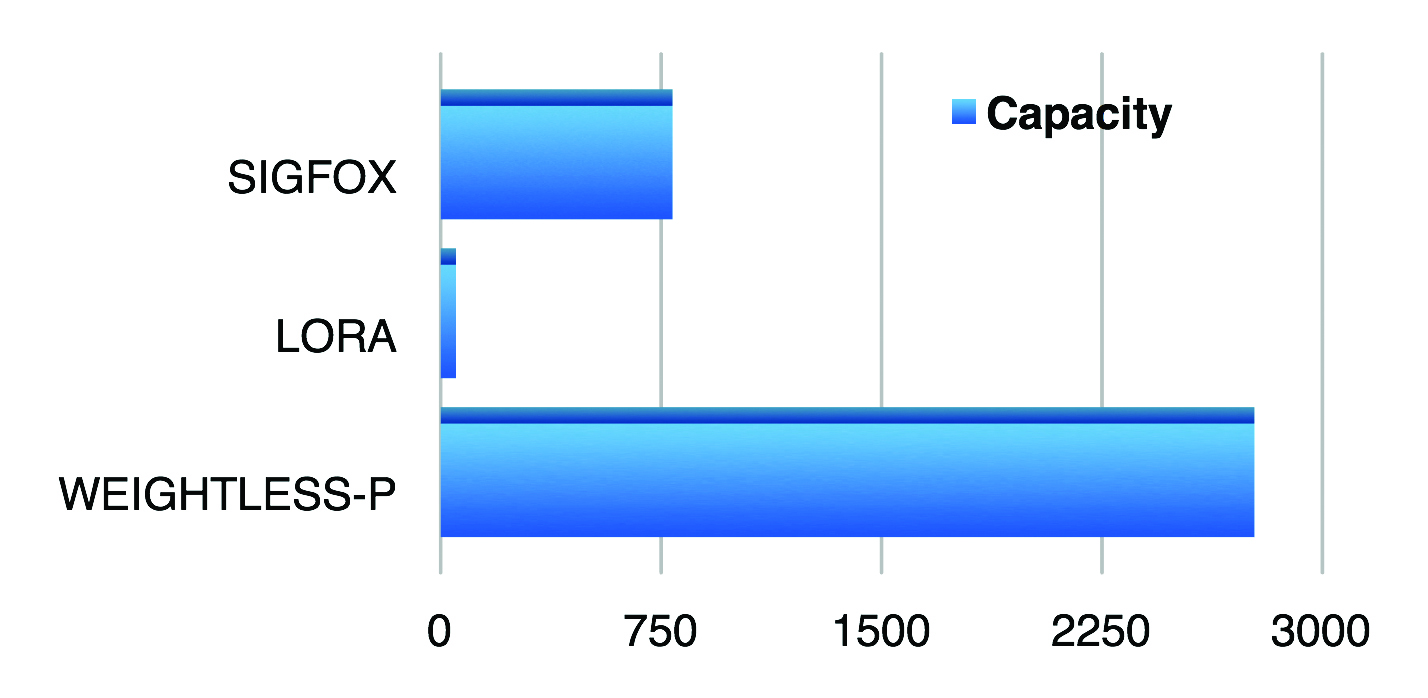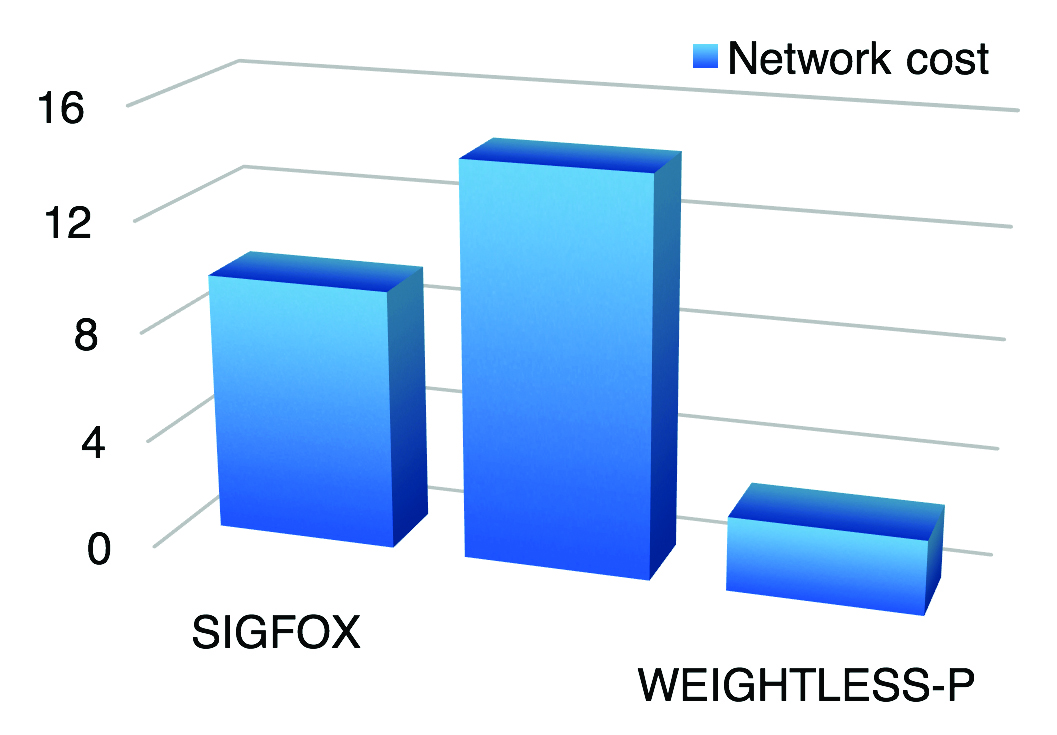BY FABIEN PETITGRAND
Chief Technology Officer, Ubiik
www.ubiik.com
Lots of things matter to a user, developer, or operator of a wireless IoT network — security, quality of service (QoS), reliability, energy consumption, etc. All of these are important, but one parameter consistently tops this list: cost. It’s arguably the one that has done more to hold back the realization of the lofty projections for IoT than any other. And a major contributing factor to this cost has consistently gone unrecognized: network capacity.
Network capacity
The primary costs in a wireless network are obviously associated with the hardware at both ends of the wireless link: the base station and the terminal device. Additional costs, such as data processing, storage, etc., are not considered here because we’re only comparing the OTA link technology. End-device BoM costs for all three technologies are reasonably equivalent; at least the differences are essentially negligible, so we’re not considering these, either.
Network capacity is arguably the most significant parameter to factor into our cost calculation. It determines cell size and, consequently, the number of base stations in the network. And base station count is the primary factor in a viable total cost of ownership calculation.
Normally, we think of network capacity as a measure of the number of end devices connected simultaneously to a single base station, so we’ll keep with this convention and see how MAC total throughput, transmission frequency, and data payload all factor into capacity calculation below.
Fig. 1 shows the MAC throughput for three popular LPWAN technologies: LoRa, Sigfox, and Weightless. These numbers pertain to EU regulations. LoRa is a spread-spectrum technology, Sigfox uses ultra-narrow-band, and Weightless-P is a narrow-band technology.
| SIGFOX | LORA | WEIGHTLESS-P | |
| MAC throughput bits/s | 1,404 | 93 | 4,923 |
Fig. 1: MAC throughput for three popular LPWAN technologies, according to EU regulations.
How did we calculate this?
We have made objective assumptions on the modelling criteria. In fact, we have been considerably more conservative in our assumptions than other published models suggest for Sigfox and LoRa. And we declare the criteria — here they are:
• Weightless-P adaptive data rate with 10-dB margin, PER target 0.1%
• Scheduled uplink capacity is calculated
• Mean data rate determined by throughput for randomly positioned nodes with properly assigned data rate
• Weightless-P: –134-dBm sensitivity for 0.625 Kbps, EU Tx power is 14 dBm, and U.S. Tx power is 27 dBm
• Sigfox and Weightless-P MAC throughput based on urban Hata model (BST antenna height 30 m and ED height 0.5 m)
• Coverage for Weightless-P is 1.5 km for EU and 3.8 km for U.S.
• LoRa MAC throughput based on Ingenu white paper but removed over-conservative assumptions on repetition rate
• Capacity loss due to slot granularity is absorbed by assuming 50% protocol overhead and 50% UL half duplex ratio
In any wireless system, the data throughput determines the achievable network capacity. Higher data throughput enables larger data packets, more frequent transmissions, and a greater number of end points. These fundamental parameters are the key factors in the scalability debate. Increase any one of these and you are stress-testing the scalability of the network. Let’s look at a typical scenario.
Smart meters
In the utility metering sector, a 15-minute reading interval is the accepted default frequency of uplink transmissions. And a data packet of 200 bytes would be considered normal. What does this mean for Sigfox, LoRa, and Weightless?
First, for this example, we could discount Sigfox based on the payload limitation of 8 bytes, but I’m using this as the basis for comparison of network capacity, so let’s keep going — 200 bytes every 15 minutes is 800 bytes/hour or, expressed in bits per second, 1.78 BPS. The MAC throughput divided by the end-device data throughput will define for us the number of nodes that can be serviced — this is how data rate and capacity are linked.
 Network capacity (end points per base station).
Network capacity (end points per base station).
Weightless-P can handle 2,769 end points per base station with these uplink characteristics; LoRa can manage 52 end points; and Sigfox can accommodate 789 end points.
Impact on cost of ownership
The CAPEX on an IoT base station might be in the region of USD$5K — let’s not get too hung up on the exact numbers. Ancillary equipment might cost USD$4K. Site engineering could cost an additional USD$7K. In terms of OPEX, site rental might be around USD$2.5–4K per year and backhaul and communications another USD$2.5–4K per year. Over a 10-year time span, the lifetime cost of the base station will be in the region of USD$50–80K. Bottom line: The BST hardware BoM cost is virtually irrelevant when calculating the total cost of ownership.
Taking the lower end of these figures, USD$50K, we can calculate the cost to cover a typical city. Let’s use San Diego, CA, as our example, with a population of just over 3 million people. The typical San Diego household has two people, deriving 1.5 million households consuming energy — each with, let’s say, one utility meter.
 Cost of ownership (lifetime cost of base station is USD$50K).
Cost of ownership (lifetime cost of base station is USD$50K).
For a Sigfox network (assuming that Sigfox’s technology was suitable for this use case) servicing 1.5 million households, approximately 1,500,000/789 base stations would be required. That is about 1,900 base stations with an approximate cost of USD$9.5 million per year.
For LoRa, the same calculation derives 1,500,000/52. This equates to about 29,000 base stations with an approximate cost of USD$14.4 million per year.
The same calculation for Weightless-P., 1,500,000/2,769 equates to 542 base stations with an approximate cost of USD$2.7 million per year.
The difference between these costs hardly needs to be pointed out and the conclusion is clear: network capacity matters. Whilst for some use cases, it might be possible to absorb the additional cost of multiple base stations, many other applications are far more price-sensitive and commercially unsustainable.
In this article, we have set out how we calculated MAC throughput in an LPWAN network. We ran the numbers for UNB, NB, and spread-spectrum modulation schemes, and we showed how this parameter in these technologies impacted an important deliverable: network capacity. We then went on to show how capacity is directly related to cost. But MAC throughput is important for other reasons, too. It has implications for virtually every characteristic that matters in an IoT network. It has a direct link to QoS, to security, and to network performance.
To provide the user with the highest QoS, it is necessary to offer acknowledgement of all uplink traffic from every node for every transmission. That requires a downlink capability that is intrinsically related to MAC throughput. So for true maximum QoS in a use case in which this is critical, don’t ask if the technology has a bidirectional capability; ask if it can offer 100% acknowledgement of uplink traffic, even in a large network. And ask the vendor to define “large.”
Security is one of the fundamental obstacles for wireless technologies, and it’s easy to see why. The over-the-air (OTA) link is a key vulnerability and the implications for a breach in a large IoT network are severe. Weightless-P, like the majority of LPWAN connectivity technologies, offers a high level of security for the OTA link with AES-128/256 encryption and authentication at both the terminal and network ends. But no security protocol is future-proofed — threats evolve continuously and need to be countered with an ever-changing protection regime. This requires the ability to update protocols at not only the network side of the link but also the terminal. With hundreds, thousands, or tens of thousands of end devices at remote locations, it is immediately clear that only an OTA firmware upgrade is commercially feasible to maintain security. No other option is realistic, and yet, without the ability to provide effective broadcast and multicast capabilities, this is simply not possible. Once again, MAC throughput is the key to this option.
Network performance is really about managing a finite resource — spectrum. Spectrum is the limiting factor and quickly becomes apparent as networks grow — in terms of the number of end devices deployed, the size of the typical data payload, and the number of transmissions sent per unit of time. A spectrally efficient technology can maintain the acknowledgement of uplink traffic for all nodes and all transmission. That means that every device can respond to changes in its environment that affects its ability to effectively communicate with the base station through dynamic configuration of both transmit power and data rate. This can only be achieved with acknowledgement of every uplink transmission from every node. And that, once again, is predicated on MAC throughput.
Advertisement





